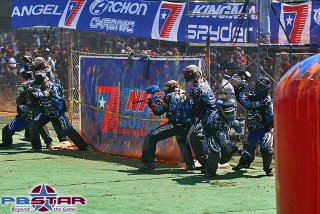Parts Included:
Features
The E-99 doesn’t have every feature in the book, but it does come very nicely equipped for just under $200. Useful features equipped on the E-99 include the Spyder ESP Frame (full-auto, 3 shot , and 6 shot burst firing modes with adjustable rates of fire for each mode), mini-expansion chamber, enlarged low pressure chamber, vertical ball feed, double finger trigger, thumb velocity adjuster, quick field strip pin, drop forward, beavertail, and sight rail.
Feature - Spyder ESP Frame:
Two things I think need to be improved on the ESP frame 1) The plastic hand grips are far too wide and not very comfortable. The grips give the frame a very square feeling and make it far too large for average adult hands. The frame is large enough that I found myself having to twist my wrist forward a bit to find a semi-comfortable shooting position. Unfortunately, I don’t know of any aftermarket, soft rubber grips made to fit the ESP frame. 2) You need the instruction manual on you to figure out how to adjust the 6 dip switches to the desired firing mode and balls per second. Sure you can try throwing the switches every which way until you get the bps right, but an LCD display would be an option worth buying. Spyder does make an LCD display version of the ESP frame, but the E-99 is only available in the version that uses dip switches.
Feature - Mini Expansion Chamber:
Feature - Vertical Feed:
Field Stripping & Maintenance
The E-99, just like the Xtra and most other Spyder markers, is very easy to field strip and clean. You can literally take the E-99 apart and put it back together in about 2 minutes. Spyder guns in general are very... very easy to maintain. A few drops of oil after each use and your gun should continue to work properly. When you take the E-99 apart, the bolt and striker are interconnected by a connecting pin, so both the bolt and striker come out at one time. This makes it a little harder if you only need to clean the bolt, but at any rate.... cleaning out the E-99 is a breeze compared to many other guns out there. The engineers at Kingman have done a great job on making the E-99 easy to clean and maintain.
The ESP frame requires no maintenance except for exterior cleaning and periodically changing the 9 volt battery it runs off of. We fired around 3,500 shots through our E-99, never needing to replace the battery. Kingman roughly estimates the life of one 9 volt battery to be about 4000 - 7000 shots. Replacing the 9v battery is very simple and straightforward. Remember to never attempt to clean the interior of the ESP frame using a liquid solvent, this could ruin the circuit board.
Balance and Field Performance
Velocity Testing:
On the Field:
After our initial accuracy and consistency testing, we packed up the E-99 and brought it to the local paintball field for the day. We used the E-99 in semi-auto mode for the duration of our field test. During our accuracy testing, we noted that the E-99 generated a large amount of air blowback into the elbow. When we stacked one or two paintballs in the elbow and watched how they feed after each shot, we could see the ball on the top of the stack jump up about 1” after each shot. This was caused by air slipping out through the elbow rather than through the barrel. We wanted to see if the blowback would effect ball feed performance, so for the first couple of games we decided to go with a non-motorized ViewLoader hopper.
After initially shooting about 100 paintballs, we experienced our first ball break. The bolt chopped a ball and paint sprayed down the barrel, and also back into the elbow. We tried to quickly squeegee the barrel and clean out the feed neck so we could finish out the game, but it is difficult to continue after a bad ball chop. After the first game, we gave the E-99 a thorough cleaning and headed back out for game two. Game 2 was yet another problem as we chopped yet another paintball about half way into the game. We had proven our theory that the E-99 needed to have an agitated (motorized) hopper, so after game 2 we switched over to a 12 Volt ViewLoader Revolution hopper. After making the switch to an agitated loader, we didn’t have any more balls get chopped in the E-99. The faster feed rate of the agitated loader kept the feed tube stacked with balls, making it much more difficult for balls to jump up after each shot. Once we made the switch over to an agitated loader, the E-99’s performance was excellent for the remainder of the day. We used just under 1,000 paintballs over the course of the day with no further problems.


